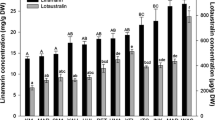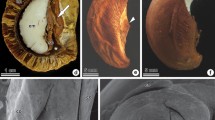Abstract
An apparent contradiction in the ecology of cycad plants is that their seeds are known to be highly poisonous, and yet they seem well adapted for seed dispersal by animals, as shown by their visually conspicuous seed cones and large seeds presented within a brightly colored fleshy “fruit” of sarcotesta. We tested if this sarcotesta could function as a reward for cycad seed dispersal fauna, by establishing if the toxic compound cycasin, known from the seeds, is absent from the sarcotesta. The Australian cycads Macrozamia miquelii and Cycas ophiolitica were tested (N = 10 individuals per species) using gas chromatography / mass spectrometry. Cycasin was detected at 0.34 % (fresh weight) in seed endosperm of M. miquelii and 0.28 % (fresh weight) in seed endosperm of C. ophiolitica. Cycasin was absent from the sarcotesta of the same propagules (none detected in the case of M. miquelii, and trace quantities detected in sarcotesta of only four of the ten C. ophiolitica propagules). This laboratory finding was supported by field observations of native animals eating the sarcotesta of these cycads but discarding the toxic seed intact. These results suggest cycads are adapted for dispersal fauna capable of swallowing the large, heavy propagules whole, digesting the non-toxic sarcotesta flesh internally, and then voiding the toxic seed intact. Megafauna species such as extant emus or cassowaries, or extinct Pleistocene megafauna such as Genyornis, are plausible candidates for such dispersal. Cycads are an ancient lineage, and the possible antiquity of their megafaunal seed dispersal adaptations are discussed.




Similar content being viewed by others
References
Ballardie RT, Whelan RJ (1986) Masting seed dispersal and seed predation in the cycad Macrozamia communis. Oecologia 70:100–105
Banack S, Cox P (2003) Biomagnification of cycad neurotoxins in flying foxes: implications for ALS-PDC in Guam. Neurol 61:387–389
Barnea A, Harborne JB, Pannell C (1993) What parts of fleshy fruits contain secondary compounds toxic to birds and why? Biochem Syst Ecol 21:421–429
Beck W (1992) Aboriginal preparation of Cycas seeds in Australia. Econ Bot 46:133–147
Bradford MG, Westcott DA (2010) Consequences of southern cassowary (Casuarius casuarius L.) gut passage and deposition pattern on the germination of rainforest seeds. Aust Ecol 35:325–333
Burbidge AH, Whelan RJ (1982) Seed dispersal in a cycad Macrozamia riedlei. Aust J Ecol 7:63–67
Butler RJ, Barrett PM, Kenrick P, Penn MG (2009) Testing co-evolutionary hypotheses over geological timescales: interactions between Mesozoic non-avian dinosaurs and cycads. Biol Rev 84:73–89
Calvino-Cancela M, Dunn RR, Van Etten EJB, Lamont BB (2006) Emus as non-standard seed dispersers and their potential for long-distance dispersal. Ecography 29:632–640
Carter T (1923) Birds of the Broome district. Emu 23:125–142
Charlton T, Marini A, Markey S, Norstog K, Duncan W (1992) Quantification of the Neurotoxin 2-Amino-3(Methylamino)- Propanoic Acid (BMAA) in Cycadales. Phytochemistry 31:3429–3432
Chemnick J (2007) Seed dispersal agents of two Mexican cycads. In: Vovides AP, Stevenson D, Osborne R (eds) Proceedings of cycad 2005 the 7th international conference on cycad biology. New York Botanical Garden Press, New York
Cox P, Sacks O (2002) Cycad neurotoxins consumption of flying foxes and ALS-PDC disease in Guam. Neurol 58:956–959
Crowley BE, Godfrey LR, Irwin MT (2011) A glance to the past: subfossils, stable isotopes, seed dispersal and lemur species loss in southern Madagascar. Am J Primatol 73:25–37
De Luca P, Moretti A, Sabato S, Gigliano GS (1980) The ubiquity of cycasin in cycads. Phytochemistry 19:2230–2231
Donatti CI, Galetti M, Pizo MA, Guimaraes PRJ, Jordano P (2007) Living in the land of ghosts: fruit traits and the importance of large mammals as seed dispersers in the Pantanal, Brazil. In: Dennis AJ, Green RJ, Schupp EW, Westcott DA (eds) Seed dispersal: theory and its application in a changing world. CAB International, Wallingford, pp 104–123
Farrera MAP, Vovides AP (2004) Spatial distribution, population structure, and fecundity of Ceratozamia matuddi lundell (Zamiaceae) in El triunfo Biosphere Reserve, Chiapas. Mex Bot Rev 70:299–311
Fragoso JM (1997) Tapir-generated seed shadows: scale-dependent patchiness in the Amazon rain forest. J Ecol 85:519–529
Fragoso JM, Silvius KM, Correa JA (2003) Long-distance seed dispersal by tapirs increases seed survival and aggregates tropical trees. Ecol 84:1998–2006
Gilardi JD, Toft CA (2012) Parrots eat nutritious foods despite toxins. PLoS ONE. doi:10.1371/journal.pone.0038293
Guimaraes PR, Galetti M, Jordano P (2008) Seed dispersal anachronisms: rethinking the fruits extinct megafauna ate. PLoS ONE. doi:10.1371/journal.pone.0001745
Hall JA, Walter GH (2013) Seed dispersal of the Australian cycad Macrozamia miquelii (Zamiaceae): are cycads megafauna-dispersed “grove forming” plants? Am J Bot 100:1127–1136
Hallwachs W (1986) Agoutis (Dasyprocta punctata): inheritors of guapinol (Hymenaea courbaril: Leguminosae). In: Estrada A, Fleming TH (eds) Frugivores and seed dispersal. Junk Publishers, Dordrecht, pp 285–304
Herrera CM (2002) Seed dispersal by vertebrates. In: Herrera CM, Pellmyr O (eds) Plant-animal interactions: an evolutionary approach. Blackwell Science, Oxford
Hill KD, Chase MW, Stevenson DW, Hills HG, Schutzman B (2003) The families and genera of cycads: a molecular phylogenetic analysis of cycadophyta based on nuclear and plastid DNA sequences. Int J Plant Sci 164:933–948
Janzen DH, Martin PS (1982) Neotropical anachronisms: the fruits the gomphotheres ate. Science 215:19–27
Johnson CN (2009) Ecological consequences of late quaternary extinctions of megafauna. Proc R Soc Ser B 276:2509–2519
Jones DL (2002) Cycads of the world. Reed New Holland Books, Sydney
Marler TE, Shaw CA (2009) Distribution of free and glycosylated sterols within Cycas micronesica plants. Sci Hortic 123:537–542
Marler TE, Lee V, Shaw CA (2005) Spatial variation of steryl glucosides in Cycas micronesica plants: within- and among-plant sampling procedures. Hortscience 40:1607–1611
Miller CN (1977) Mesozoic conifers. Bot Rev 43:217–280
Miller GH, Magee JW, Johnson BJ, Fogel ML, Spooner A, McCulloch T, Ayliffe LK (1999) Pleistocene extinction of Genyornis newtoni: human impact on Australian megafauna. Science 283:205–208
Molyneux RJ, Lee ST, Gardner DR, Panter KE, James LF (2007) Phytochemicals: the good the bad and the ugly? Phytochemistry 68:2973–2985
Moretti A, Sabato S, Gigliano S (1981) Distribution of macrozamin in Australasian cycads. Phytochemistry 20:1415–1416
Moretti A, Sabato S, Gigliano S (1983) Taxonomic significance of methylazoxymethanol glycosides in the cycads. Phytochemistry 22:115–117
Murray PF, Vickers-Rich P (2004) Magnificent mihirungs: the colossal flightless birds of the Australian dreamtime. Indiana University Press, Indiana
Nair JJ, van Staden J (2012) Isolation and quantification of the toxic methylazoxymethanol glycoside macrozamin in selected South African cycad species. S Afr J Bot 82:796–799
Norman D (2000) Feeding adaptations in the Dinosauria. In: Paul GS (ed) The Scientific American book of dinosaurs. St Martin’s Griffen Books, New York
Norstog KJ, Nicholls TJ (1997) The biology of the cycads. Cornell University Press, Ithaca
Perez-Farrera MA, Vovides AP, Octavio-Aguilar P, Gonzalez-Astorga J, de la Cruz-Rodriguez J, Hernandez-Jonapa R, Villalobos-Mandez SM (2006) Demography of the cycad Ceratozamia mirandae (Zamiaceae) under disturbed and undisturbed conditions in a biosphere reserve of Mexico. Plant Ecol 187:97–108
Price GJ (2008) Taxonomy and palaeobiology of the largest-ever marsupial Diprotodon Owen 1838 (Diprotodontidae Marsupialia). Zool J Linnean Soc 153:369–397
Roberts RG, Flannery TF, Ayliffe LK, Yoshida H, Olley JM, Prideeaux GJ, Laslett GM, Baynes A, Smith MA, Jones R, Smith BL (2001) New ages for the last Australian megafauna: continent-wide extinction about 46000 years ago. Science 292:1888–1892
Sargent OH (1928) Reactions between birds and plants. Emu 27:185–192
Saul R, Chambers JP, Molyneux RJ, Elbein AD (1983) Castanospermine: a tetrahydroxylated alkaloid that inhibits β-glucosidase and β-glucocerebrosidase. Arch Biochem Biophys 221:593–597
Seawright A, Ng JC, Oelrichs PB, Sani Y, Nolan CC, Lister AT, Holton J, Ray DE, Osborne R (1999) Recent toxicity studies in animals using chemical derived from cycads. In: Chen CJ (ed) Proceedings of the fourth international conference on cycad biology. International Academic Publishers, Beijing
Snow EL, Walter GH (2007) Large seeds extinct vectors and contemporary ecology: testing dispersal in a locally distributed cycad Macrozamia lucida (Zamiaceae). Aust J Bot 55:592–600
Spencer P, Nunn P, Hugon J, Ludolph A, Ross S, Dwijendra R, Robertson R (1987) Guam amyotrophic lateral sclerosis-parkinsonism-dementia linked to a plant excitant neurotoxin. Science 237:517–522
Stevenson D (1990) Morphology and systematics of the Cycadales. Mem New York Bot Gard 57:8–55
Tang W (1989) Seed dispersal in the cycad Zamia pumila in Florida. Can J Bot 67:2066–2070
Terry I, Forster PI, Moore CJ, Roemer RB, Machin PJ (2008) Demographics pollination syndrome and conservation status of Macrozamia platyrhachis (Zamiaceae) a geographically restricted Queensland cycad. Aust J Bot 56:321–332
Thieret JW (1958) Economic botany of the cycads. Econ Bot 67:2066–2070
Van Der Pijl L (1982) Principles of dispersal in higher plants. Springer, New York
Vidakovic M (1991) Conifers: morphology and variation. Graficki Zavod Hrvatske, Zagreb
Vovides AP (1990) Spatial distribution, survival and fecundity of Dioon edule (Zamiaceae) in a tropical deciduous forest in Veracruz, Mexico, with notes on its habitat. Am J Bot 77:1532–1543
Vovides AP, Norstog KJ, Duncan MW, Nash RJ, Molsen DV (1993) Histological changes during maturation in male and female cones of the cycad Zamia furfuracea and their significance in relation to pollination biology. Bot J Linn Soc 111:241–252
White HL (1913) Notes on the cassowary (Casuarius australis Wall). Emu 12:172–181
Whiting MG (1963) Toxicity of cycads. Econ Bot 17:271–302
Williams PA, Karl BJ (1996) Fleshy fruits of indigenous and adventive plants in the diet of birds in forest remnants, Nelson, New Zealand. N.Z. J Ecol 20:127–145
Willson MF, Sabag C, Figueroa J, Armesto JJ (1996) Frugivory and seed dispersal of Podocarpus nubigena in Chiloe Chile. Rev Chil Hist Nat 69:343–349
Wirminghaus JO, Downs CT, Symes CT, Perrin MR (2001) Fruiting in two afromontane forests in KwaZulu-Natal South Africa: the habitat type of the endangered Cape parrot Poicephalus robustus. S Afr J Bot 67:325–332
Yagi F (2004) Azoxyglycoside content and b-glycosidase activities in leaves of various cycads. Phytochemistry 65:3243–3247
Zaya DN, Howe HF (2009) The anomalous Kentucky coffeetree: megafaunal fruit sinking to extinction? Oecologia 161:221–226
Zhifeng Z, Thomas BA (1989) A review of fossil cycad megasporophylls with new evidence of Crossozamia pomel and its associated leaves from the lower Permian of Taiyuan China. Rev Palaeobot Palynol 60:205–223
Acknowledgments
The GCMS method for the detection of cycasin was developed by Mr Grahame Kervan (UQ School of Land, Crop and Food Sciences). Our sincere thanks to him, as well as Dr Leslie Force and Dr Jennifer Waanders (UQ School of Land, Crop and Food Sciences) and Dr Susanne Schmidt (UQ School of Biological Sciences) for their assistance in the implementation of this GC/MS technique, and the interpretation of the results. We also thank Dr Chris Moore for suggesting some improvements to the draft and and giving us the benefit of considerable expertise in analytical chemistry. This study would not have been possible without the kind support Dr Glen Kisby (Oregon Health and Science University) in generously providing a pure standard of the toxic compound cycasin. We thank Dr James Gilardi (World Parrot Trust) for help in interpreting his published data (Gilardi and Toft 2012) on the toxicity of seeds and fruits in the diet of Amazonian parrots. The collection of wild cycad seed discussed in this paper was undertaken in conjunction with the Queensland Government Department of Environment and Resource Management scientific purposes permit number WITK06373009.
Author information
Authors and Affiliations
Corresponding author
Rights and permissions
About this article
Cite this article
Hall, J.A., Walter, G.H. Relative Seed and Fruit Toxicity of the Australian Cycads Macrozamia miquelii and Cycas ophiolitica: Further Evidence for a Megafaunal Seed Dispersal Syndrome in Cycads, and Its Possible Antiquity. J Chem Ecol 40, 860–868 (2014). https://doi.org/10.1007/s10886-014-0490-5
Received:
Revised:
Accepted:
Published:
Issue Date:
DOI: https://doi.org/10.1007/s10886-014-0490-5




